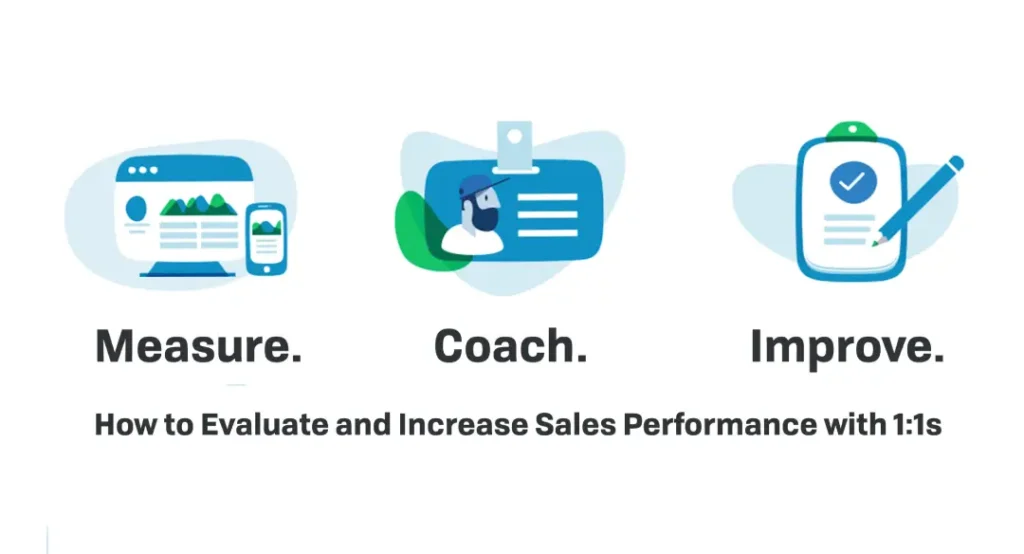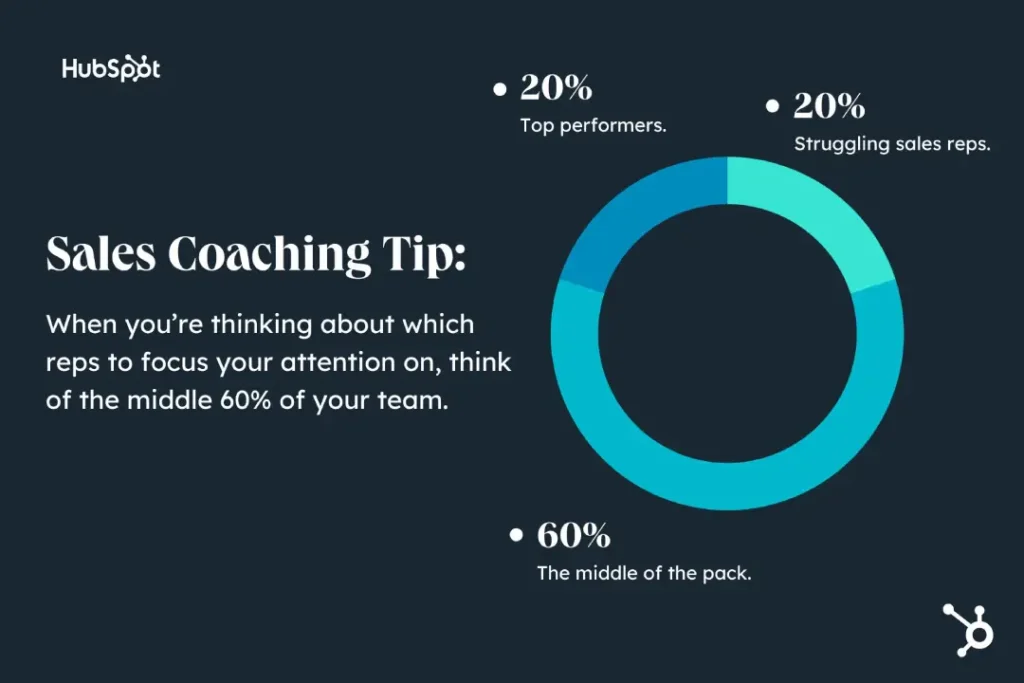The Power of Sales Coaching: Unlock Your Team's Potential
Do you know the feeling of signing a massive deal after months of hard work? That rush of adrenaline and sense of accomplishment? What if your entire sales team could feel that way all the time? That’s what good sales coaching can do.
Salesforce excellence is something every sales leader strives for. With so much talent in the industry today, hiring great reps isn’t enough. You need a strategic plan for skill development if you want them to reach their full potential. That’s where sales coaching comes in.
Table of Contents
What is Sales Coaching?

Sales coaching is about enabling continuous improvement and pushing people to be better than they were yesterday. It’s an ongoing process where managers personalise advice around each team member's areas for growth or aspirations for greatness.
It is not just about fixing what is broken; it also involves recognising strengths, honing skills, and boosting confidence levels and mindsets needed for success, thereby making it a personalised coaching program that suits individuals’ needs and learning preferences.
The Advantages of Sales Coaching
Still not buying it? Let’s talk about some benefits in terms of cold hard cash an effective sales coaching program can bring to your business:
- Increase in Revenue and Quota Attainment: When representatives perform at their peak, they close more deals and bring in more money. Research has proven that organisations with coaching programs have much higher win rates and quota attainment.
- Better Skill Development: Prospecting, negotiating, and building rapport are just skills reps can learn through coaching. As their abilities sharpen, so does overall effectiveness and self-assurance.
- Retention and Engagement: People who feel cared for and invested in stick around longer. By showing them you’re willing to help them get better at what they do best, coaches inspire loyalty that translates into commitment on the job.
- Consistent Sales Methodology: Aligning your team’s understanding of the sales process with the organisation’s can make outcomes more repeatable – AND scalable, too!
- Speed up Onboarding Process: Personalized coaching helps new hires become productive faster by reducing ramp-up time.
The Mindset Behind Coaching
Effective sales coaching is not only about tactics or techniques; it’s a mindset. You must shift from managing people to developing them as leaders if you want true success as a coach in any field, including sales!
Here are some elements which would be part of such a mindset:
- Embrace Growth Mindset: Believe that everyone has potential for growth, including yourself, but also foster this belief among those you lead, i.e., inner circle (team members).
- Partner Not Boss: Remember that all relationships need collaboration, especially when working together closely, like a boss-subordinate relationship between boss/coach & employee/salesperson.
- Listening And Observing Skills: One needs to know strengths, weaknesses, learning styles, etc., if he wants his criticism or praise (feedback) to be taken positively by the individuals involved.
- Ask Questions Instead Of Providing Answers In Certain Cases/Instances Where Appropriate: This helps them think critically to develop solutions.
- Feedback Should Be Constructive And Delivered With Empathy: True feedback is necessary for personal/professional development but only when given in a manner that preserves self-esteem or does not hurt anyone’s feelings.
Building a Coaching Culture

Though one-on-one coaching is effective, creating a coaching culture will increase its potential within an organisation. This means that sales teams should integrate coaching into their system to learn and improve continuously.
The Role of Sales Leadership
As a sales leader, you can make or break this culture. Here are some things you can do:
- Lead by Example: Show the attitude of a coach and exemplify what good coaching behaviours are in your team.
- Provide Coaching Training: Develop managers’ and front-line supervisors’ skills by training them to coach effectively.
- Allocate Time and Resources: Set aside specific periods for coaching activities and devote necessary resources towards it.
- Celebrate Coaching Wins: Recognize coaches who have demonstrated good coaching practices and coachees who have benefited positively from such support systems while emphasising its significance more.
- Measure and Adjust: Keep checking whether your program is working out well or not; if not, then make changes immediately without waiting too long before doing so.
Peer-to-Peer Coaching
Besides top-down mentoring programs, they also encourage peer-to-peer mentorship programs because they enable representatives to learn from each other’s experiences, thus enabling the sharing of best practices among themselves and ensuring personal responsibility towards achieving desired goals collectively within given timelines.
To facilitate peer-to-peer coaching, you can:
- Establish mentor-mentee relationships
- Create opportunities for job shadowing and ride-along
- Encourage reps to provide feedback and coaching to their peers
- Facilitate regular knowledge-sharing sessions or “lunch and learns.”
Integrating Technology
Coaching efforts need support, especially in today's digital world, where everything happens simultaneously through technology. You can use different applications, including Sales Enablement Platforms, Learning Management Systems (LMSs), etcetera, all aimed at improving efficiency levels during training sessions, among others, carried out under such programs and making them more effective.
For example, you can:
- Record and review sales calls for coaching purposes
- Deliver micro-learning modules and just-in-time coaching
- Track individual and team performance metrics
- Facilitate virtual coaching sessions and knowledge-sharing
Remember that technology should be used as an aid but not a substitute for human intervention in these cases, as stated earlier.
The Coaching Cycle

Now that we’ve covered the basics let’s get into actual coaching. The cycle of effective sales coaching is a cyclical process where each stage builds off the one before it.
1. Evaluation and Goal Setting
The first step in the coaching cycle is assessing your reps’ current skillsets, performance levels, and areas for improvement. Here are a few ways to do that:
- Analyse performance metrics and sales data
- Conduct skills assessments or simulations
- Observe sales calls or accompany reps in the field
- Collect feedback from reps, peers, and customers
With this evaluation in mind, work with each rep to set specific, measurable goals that are achievable within a certain time frame. Objectives should be aligned with individual development needs and overall organisational sales targets.
2. Skill Building
Once goals have been set, focus on developing the skills necessary for achieving them. This can be done through various coaching activities such as:
- Role-playing and skill practice
- Classroom or online training sessions
- Shadowing top performers or observing experts in action
- Providing feedback on strengths and areas needing improvement
- Assigning resources for further development (books/videos/courses)
Remember to adapt skill-building exercises according to the unique learning style of each representative involved – keep things interesting!
3. Application & Feedback
At this point, knowledge alone won’t suffice; there must be opportunities for reps to apply the learnt materials in the practical conditions prevailing in their work environment. Some ways include;
- Watching reps during live demos (sales calls/presentations/negotiations)
- After watching them perform these tasks, give instant, precise advice and constructive criticism where necessary.
- Highlight places where more reinforcement may be required due to lack thereof or weak understanding shown during previous stages while giving additional instructions to bridge these gaps, if any exists between what was taught earlier versus current expectations, etcetera.
- Consistent feedback provision throughout this phase plays a vital role towards helping salespeople internalise fresh abilities and make appropriate changes.
4. Review and Adaptation
Since coaching is an ongoing process, it is essential to assess progress regularly to adjust where necessary. Here’s what you should do:
- Check performance metrics against goals regularly
- Seek feedback from reps about how they feel the coaching is going for them.
- Identify any new areas that may require further skills development or additional resources towards bridging this gap if there exists any between previous knowledge acquired vis-à-vis current needs of the team.
- Modify coaching activities/goals accordingly, etcetera, while constantly reviewing what worked well during these stages, ensuring continuous improvement aligned with changing requirements within your organisation.
Coaching Techniques and Best Practices

Although the coaching cycle gives a structure to follow, it can be made more effective through different methods and best practices.
Active Listening
Effective coaching is built on understanding reps’ perspectives, challenges, and motivations. Active listening is crucial in gaining this understanding. Here are some tips for active listening:
- Keep eye contact and an open posture
- Don’t interrupt or assume you know what they’re going to say
- Ask questions to make sure you get it right
- Repeat or rephrase what has been said
- I agree with them sometimes
Through this, one establishes trust, a basis for meaningful coaching conversations.
The GROW Model
The GROW model is a widely used framework that helps structure coaching sessions and discussions. It stands for:
- Goal: State the specific goal or desired outcome of the coaching session.
- Reality: Look into the current situation, challenges, obstacles, etc.
- Options: Brainstorm possible solutions or strategies that work well under such circumstances.
- Will: Identify the specific actions that need to be done by whom within what period; set targets for accountability purposes.
This model promotes solution thinking while empowering representatives towards their growth journey.
Questioning Techniques
Asking good questions is an effective way of coaching people. This helps them think critically, thus allowing them to discover new insights that will eventually lead them to find solutions. Below are several helpful questioning techniques:
- Open-ended Questions- These types require more than just yes/no answers because they encourage deeper reflection about oneself or others involved;
- Probing Questions- They challenge initial responses by seeking further details either to confirm understanding so far gained on specific issues discussed during conversation or else shed light where necessary;
- Reflective Questions-Make use of what has already been said but in the form of a question, thereby making someone elaborate further on their statement;
- Hypothetical Questions start with “what if”, thus encouraging thoughts beyond current reality where imagination becomes a key factor towards finding suitable answers.
Knowing how to ask questions well makes conversations more exciting and impactful during a coaching session.
Feedback and Reinforcement
Coaching should involve feedback, as this is an integral part of development. However, it needs to be appropriately delivered for it to bring change. These are the tips for giving constructive criticism:
- Be Specific: Make sure your comments are explicit by using real examples related to behaviour shown or outcomes achieved;
- Focus on Behavior, not Person: Avoid personal attacks but rather concentrate on actions that require improvement;
- Use Sandwich Method: Begin with something positive followed by a negative aspect, then finish off with an encouraging statement;
- Invite Dialogue: Allow them to air their views concerning specific issues raised by giving feedback;
- Follow Up & Reinforce: Ensure continuous support, such as monitoring progress made over time through practice sessions until the outcome meets desired standards.
This way, individuals will have confidence in themselves since they can see where they’ve come from and how far they still need to go, enhancing personal growth even further.
Coaching for Different Learning Styles
People learn differently and respond to various approaches during coaching sessions. Adapting one’s style depending on these preferences significantly improves the effectiveness of coaching efforts. Below are some common learning styles:
- Visual Learners- These individuals like seeing things and thus respond well when presented with demonstrations, charts or any other forms containing relevant information that can be seen;
- Auditory Learners- They prefer listening, so talking about ideas while involving them through role plays or having discussions around specific topics would work best here;
- Kinesthetic Learners- Such people need hands-on experience; therefore, let them participate actively during practice sessions either individually or collectively within a group setting but ensure skills learnt are applicable elsewhere, too;
- Analytical Learners- Individuals who appreciate logic will require data analysis plus using models alongside stepwise procedures.
Teaching for Different Skill Levels
Another essential thing to consider is how you teach people with different amounts of experience. Here is what you could do when coaching various groups:
- Beginners: Ensure they have fundamental skills, know the product, and know your sales technique. Give them more structured training and check on them frequently.
- Professionals: Use their already acquired knowledge as a tool to improve higher-level skills, solve particular problems, and share best practices.
- Top performers: Set hard-to-reach targets for such workers; give them new responsibilities or even positions; and organise coaching between peers.
- Low performers: Find out what has led to this state of affairs; help them develop specific necessary abilities; think about teaming up with an excellent mentor or coach.
Regarding skill level, if you modify your strategy like this, it will make your teaching efforts more relevant, practical, and specific to the needs of every student.
Measuring the Impact of Sales Coaching

It is essential to measure the success of any program. Here are some metrics you should consider:
- Metrics for Personal and Team Performance: To know how much sales performance has been impacted directly, monitor quota attainment rates, win-loss ratios, deal sizes and cycle times.
- Skills Evaluation Scores: Carry out skill assessments frequently to ascertain whether there have been any improvements in specific skill sets that were being coached.
- Coaching Engagement and Adoption: Track levels of involvement in coaching sessions and feedback given by representatives to determine which programs are more engaging than others.
- Satisfaction of Employees and Employee Retention: Representatives who feel engaged because they receive good coaching will be satisfied at work and stay longer with the company; hence, looking into employee satisfaction ratings alongside turnover figures is necessary.
- Customer Satisfaction Index (CSI): When reps improve their selling skills, customers also get better experiences, leading us to monitor customer satisfaction index scores plus Net Promoter Score(s) (NPS).
Reviewing these indicators frequently while connecting them with what was done during coaching will help improve your program each time until it becomes extraordinary.
Conclusion
Sales training is not just something that would be nice to have; it is a strategic imperative for any organisation aiming at consistently achieving sales success. You can unlock the full potential of your sales team by adopting a mindset of coaching, creating a coaching culture as well as implementing an effective coaching program.
One should remember that coaching is a process and not an event. It needs continuous commitment, adjustment and relentless emphasis on getting better all the time. However, these benefits, such as increased revenue generation, higher employee involvement, and competitive advantage in the market, are worth it.
So what are you still waiting for? Take up sales coaching today and see how far your team can go!
FAQs
How often should I coach my reps? What is the frequency of coaching the employees?
Well, this is determined by a few things like performance level, experience of the rep and what they need to grow. As a rule of thumb, try having weekly or bi-weekly sessions for coaching and then top that with any additional or spontaneous coaching.
Can I coach remotely, or must it be done in person?
Both methods are just as effective. You can use video conferencing platforms and virtual coaching tools to quickly guide representatives wherever they may be based. The most important thing is ensuring active involvement and creating an environment that supports learning.
How do I balance coaching with my other management responsibilities?
Time management is key here; schedule blocks on your calendar specifically for coaching sessions, delegate duties where possible and employ technology to streamline different processes. In addition, you could empower some of your best performers to help mentor others, thus reducing workload.
What if my reps are resistant to coaching?
Typically, people resist because they don’t trust their seniors enough not to criticise them unduly during such exercises or misunderstand this whole concept altogether. Allay these fears honestly, showing why each staff member needs to develop their skills further through personal goal setting and celebrating small wins, which will gradually build support.
How do I become an effective sales coach if I've never been coached?
Immerse yourself into programs designed to impart relevant knowledge on how best to act like mentorship may work out reading books about successful coaches who have made it big time, joining courses related towards becoming better at guiding others through their career paths, etcetera then practising whenever possible, till perfection achieved but still keep refining constantly looking for new tips while observing those around us succeed.
What's the difference between coaching and managing?
Simply put, management entails telling people what to do and evaluating performance levels against set targets. On the contrary, coaching is about development, where reps are helped to realise their full potential by providing necessary guidance, feedback, plus support till desired skill sets are attained.
Can I coach all my reps the same way?
No. Coaching is more effective when customised for individual needs, which may vary depending on experience levels, thus making uniformity unsuitable since one size will only fit some equally.
How can I measure the ROI of my coaching program?
Keep track of key performance indicators like win rates, deal sizes closed per representative, customer satisfaction levels achieved post-sales training, etc., and correlate these figures against specific activities carried out during different phases to determine actual returns on investment made.
What resources are available to support my coaching efforts?
Reputable institutions offer many online courses that focus entirely on various aspects of salesmanship, such as improving negotiation skills and closing deals faster. Additionally, some publishers provide materials specifically tailored towards enhancing managerial prowess within organisations where mentoring forms part & parcel, such as Harvard Business Review publications, among other similar works.
